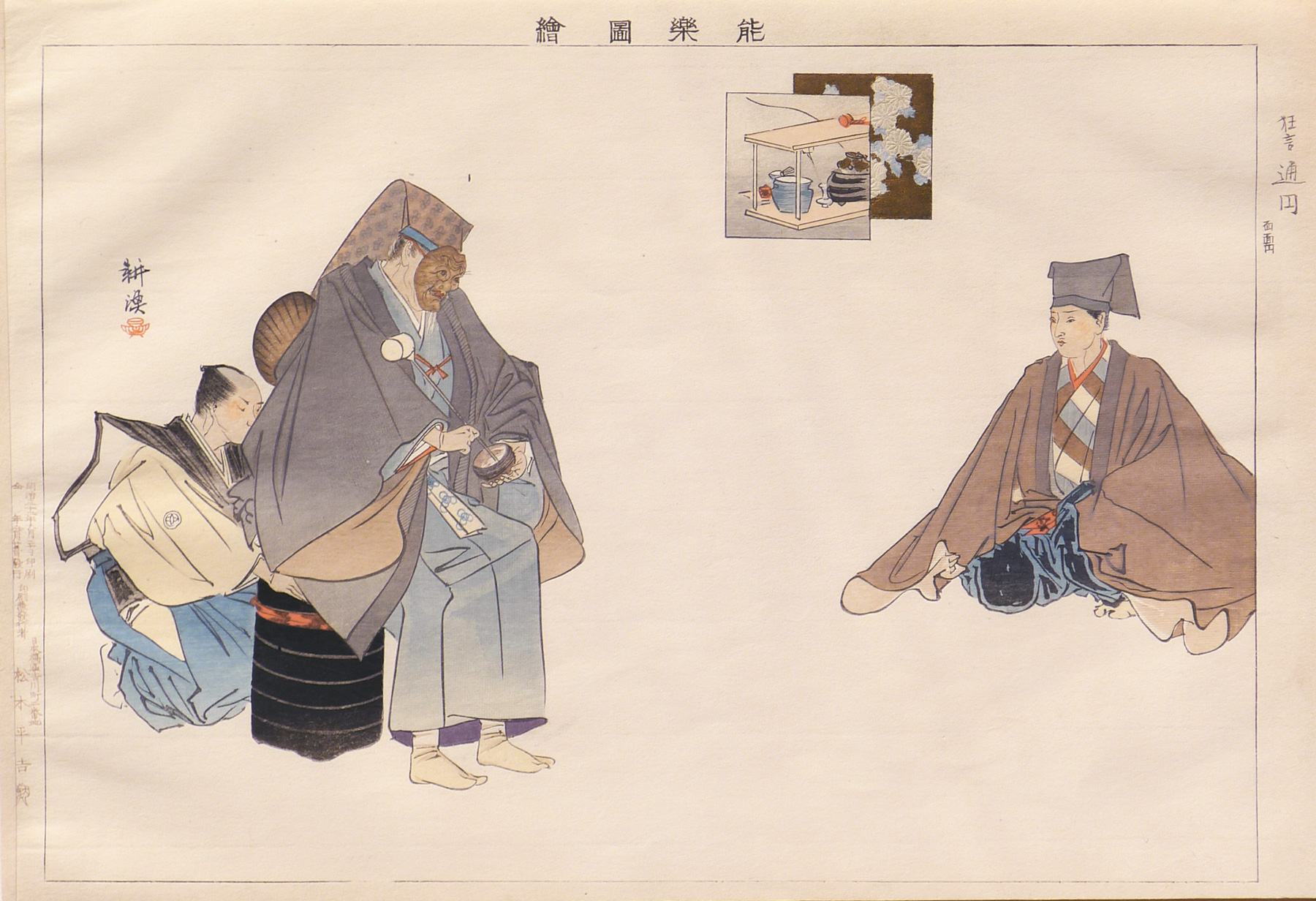About This Print
One of 261 prints from the series Nōgakuzue (Illustrations of Noh). The print depicts a scene from the kyōgen Tsūen, a parody of the Noh play Yorimasa.
The Play - Tsūen
Source: Traditional Japanese Theater: An Anthology of Plays, Karen Brazell, Columbia University Press, 1998, 284.
A small group of kyōgen plays (mai kyōgen, or “dance kyōgen”) aredirect parodies of noh ghost plays. In noh, it is usually the ghost of a well-known warrior or a talented or beautifulwoman who comes to life on stage, whereas in kyōgen the human ghosts are morelowly [such as] an overworked teahouse proprietor in Tsūen.
Shite Ghost of Tsuen
Waki Priest
Ai Villager
This Kyōgen is a Nōgakari, meaning it is written in the form of a Noh Drama.
A Priest comes along the road to a tea house, and finds it without a priest in charge of making and serving teas. He asks the reason of a Villager who tells him that this tea hourse belonged to a Priest named Tsūen. It has been kept as a memorial since he died, and that today is the anniversary of his death. Then the Villager asks the Priest to pray for Tsūen’s soul. The Priest begins to pray, and the Ghost of Tsūen appears, tells the story of his life, dances, and serves the Priest tea.
A small group of kyōgen plays (mai kyōgen, or “dance kyōgen”) aredirect parodies of noh ghost plays. In noh, it is usually the ghost of a well-known warrior or a talented or beautifulwoman who comes to life on stage, whereas in kyōgen the human ghosts are morelowly [such as] an overworked teahouse proprietor in Tsūen.
In addition to spotlighting incongruousheroes, these plays create humor parodying the language, structure, and performance practices ofnoh. One of them, Tsūen, contains analmost line-by-line parody of the battle scene from the noh warrior play Yorimasa. The warrior Yorimasa fought againstoverwhelming odds, and then, when defeat was certain, he took his ownlife. The tea master Tsūen,overcome by the crush of too many customers on the occasion of the dedicationof new bridge at Uji, whisks himself away from life. The setting for both plays is Uji, famous forits tea.
Shite Ghost of Tsuen
Waki Priest
Ai Villager
This Kyōgen is a Nōgakari, meaning it is written in the form of a Noh Drama.
A Priest comes along the road to a tea house, and finds it without a priest in charge of making and serving teas. He asks the reason of a Villager who tells him that this tea hourse belonged to a Priest named Tsūen. It has been kept as a memorial since he died, and that today is the anniversary of his death. Then the Villager asks the Priest to pray for Tsūen’s soul. The Priest begins to pray, and the Ghost of Tsūen appears, tells the story of his life, dances, and serves the Priest tea.
Print Details
| IHL Catalog | #944 |
| Title | Tsūen 通円 (Tsūen, The Tea Priest) |
| Series | Nōgakuzue 能樂圖繪 (Illustrations of Noh) |
| Artist | Tsukioka Kōgyo (1869-1927) |
| Signature | Kōgyo |
| Seal |  |
| Date | Printed on September 20, 1899 / Issued on September 25, 1899 (Meiji 32) 明治三十二年九月二十日 印刷仝年仝月廿五日発行 The ARC database entry for their print arcUP1045 carries a later date than this collection's print, as follows: 明治三十四年十月一日印刷仝年仝月十日発行 Date of Printing: October 1, 1901; Date of Issuance: October 10, 1901 |
| Edition | unknown |
| Publisher | Matsuki Heikichi (Daikokuya Heikichi 大黒屋平) [Marks: pub. ref. 029] |
| Carver | |
| Impression | excellent |
| Colors | excellent |
| Condition | excellent |
| Genre | ukiyo-e |
| Miscellaneous | |
| Format | oban yoko-e |
| H x W Paper | 9 5/8 x 14 1/4 in. (24.4 x 36.2 cm) |
| H x W Image | 8 3/4 x 13 in. (22.2 x 33 cm) area within printed black border |
| Collections This Print | University of Pittsburgh Special Collections 20091209-kogyo-0388; Scripps College Ruth Chandler Williamson Gallery 2009.7.47; Art Institute Chicago 1939.2258.197; Art Research Center, Ritsumeikan University AcNo.arcUP1045 CoGNo.arcUP0840AlGNo.arcUP0840 and AcNo.arcUP0836 CoGNo.arcUP0735AlGNo.arcUP0735 |
| Reference Literature |


